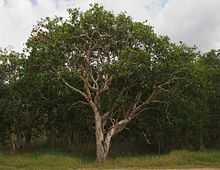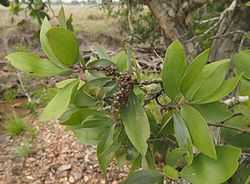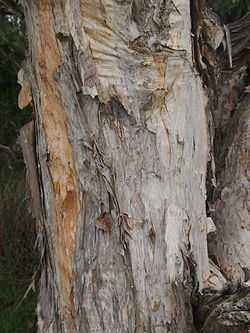Melaleuca viridiflora
| Melaleuca viridiflora | |
|---|---|
 | |
| Scientific classification | |
| Kingdom: | Plantae |
| (unranked): | Angiosperms |
| (unranked): | Eudicots |
| (unranked): | Rosids |
| Order: | Myrtales |
| Family: | Myrtaceae |
| Genus: | Melaleuca |
| Species: | M. viridiflora |
| Binomial name | |
| Melaleuca viridiflora | |
Melaleuca viridiflora, known as broad-leaved paperbark, is a small tree native to woodlands, swamps and streams of monsoonal northern Australia and Papua New Guinea.
The leaves are thick, broadly elliptic, aromatic and 7–19 cm long. Flowers are cream, yellow, yellow-green or occasionally red spikes, 5–10 cm long.[1] Fruits are woody capsules containing numerous fine seed. The bark is papery.
Uses

M. viridiflora is used by Indigenous Australians for multiple uses. The bark is peeled off in layers and is used for shelter, bedding, containers, storing and cooking food, fire tinder, water craft, fish traps and wrapping corpses.
In traditional medicine, an infusion from leaves was drunk, inhaled or used for bathing to treat coughs, colds, congestion, headache, fever and influenza.[2]
A methyl cinnamate/ocimene chemotype of M. viridiflora from western Cape York is used as a bushfood spice, and is called kitcha-kontoo.
The essential oil is an ingredient in a "natural" haemorrhoid treatment.[3]
Distribution

The species occurs in New Guinea and tropical areas of Australia, including northern parts of Western Australia, the Northern Territory and Queensland.[4]
Plants distributed in south-eastern Florida in 1900 under the name Melaleuca viridiflora have been subsequently identified as Melaleuca quinquenervia.[5]
References
- ↑ http://anpsa.org.au/m-vir.html
- ↑ Brock, J., Top End Native Plants, 1988. ISBN 0-7316-0859-3
- ↑ http://www.amoils.com/h-hemorrhoids-ingredients.html, http://www.amoils.com/hemorrhoids.html
- ↑ "Melaleuca viridiflora". Association of Societies for Growing Australian Plants (ASGAP). Retrieved 2008-07-27.
- ↑ Dray Jr., F. Allen.; Bradley C. Bennett; Ted D. Center (2006). "Invasion History of Melaleuca quinquenervia (Cav.) S.T. Blake in Florida". Castanea 71 (3): 210–225. doi:10.2179/05-27.1.